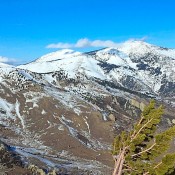
Text and Photos by Tom Lopez
The Albion Range is Idaho’s most important destination for climbers south of the Snake River. It offers opportunities for bouldering, technical rock climbing and scrambling. The range extends north from the Utah border for 25 miles to a point just southeast of Burley, Idaho in the South Central part of the State. Included in its inventory are Cache Peak (10,339 feet)–the highest point in Idaho south of the Snake River–and the City of Rock, a concentration of granite domes and spires which is the premier rock climbing area in the State.The range is typical of the nearby Great Basin ranges, with which it shares many similarities.
A variety of environments are present to stimulate the senses, ranging from bare and windswept summits to thick stands of Douglas fir to and desert-like lower slopes. It is among these dry lower slopes that the City of Rocks is situated. Water is present throughout the range although its quality cannot be guaranteed. The surrounding country is big and open, with smaller North-South trending mountain ranges interspersed by wide sagebrush-covered flats. An exception is the Raft River Range, located just south of the Idaho border, which runs in an uncommon East-to-West direction. See Summit, November-December 1972.
Historically, the range gained early notoriety from its association with the Oregon Trail. In fact, the “Silent City of Rock” not only fascinated the early immigrants who traveled west over the Oregon Trail, but also served as a major junction along the route. It was from this point that many pioneers broke off to follow either the Hudspeth Cutoff Trail or the Salt Lake Cutoff Trail. In the early 1860s, over 50,000 immigrants passed through the City in a single year.The geology of the range is highlighted by the granitic Cassia Batholith which pushed up through the Earth’s crust. The range is formed by 2 large, rolling ridges which accumulate into 2 main summits: Mount Harrison (9,265 feet) in the north and Cache Peak in the south.
A glacial cirque is nestled into the East Slopes of Cache Peak. The cirque holds several high lakes which are the only mountain lakes present in Idaho’s 27 mountain ranges located south of the Snake River. While overlying sedimentary rocks are still present throughout the range, it is the batholith’s granite that is of primary interest to climbers. Climbing the major peaks of the Albion Range is generally limited to long tedious scrambles that lead to rewarding views. Cache Peak can be reached from several directions. One route leads up from Independence Lakes to the saddle between Cache Peak and Mount Independence. Both peaks can be reached from the saddle.
Unlimited technical climbing is available throughout the City of Rocks. These opportunities are situated in 4 main locations: the head of Circle Creek, the main formations in the City of Rocks proper, the Castle Rock area and the Twin Sisters. While climbing in the City of Rocks has never been documented, many of the formations have been informally named and established routes exist on most of them.
Climbers who have visited this out-of-the-way place feel that it is one of the finest climbing spots in the country. The granite has a rough texture which is perfect for friction climbing. Although most routes are from one to two pitches in length, there are an infinite number of routes available. The large variety of shapes present a wide spectrum of daring problems from cracks to chimneys, large faces, and obelisk-shaped spires.
Climbing is best in the Spring when the City’s desert-like climate warms up long before surrounding mountains have even begun to melt out. During Memorial Day weekend, many climbers from all over Idaho, Jackson (Wyoming) and Salt Lake City areas congregate at the City of Rocks.
The heart of the City of Rocks is easily reached by road and contains a number of impressive formations including Window Rock, Bath Rock and Morning Glory Spire. Elephant Rock is one of the most prominent formations. Located at the City’s main entrance, this rock is only 50 yards from the road for those who have absolutely no interest in hiking.
The upper valley can be reached by trail from Elephant Rock. A trail leaves the parking area and generally follows a fence line for a mile into the upper reaches of Circle Creek. There are no signs. The Box Top and Lost Arrow formations are the most important of the dozens of formations located along Circle Creek. Even on a busy Memorial Day weekend when climbers wait in line to do a crack on Elephant Rock, this area sees relatively little use.
The Twin Sisters formations are located over one mile south of the main City of Rocks. The BLM has provided an established campground (Smoky Mountain Campground) in addition to over 80 individual campsites scattered along the main road through the City of Rocks. The Twin Sisters tower over 600 feet.
Additional Information
State Highways 27 and 77 are on the range’s West and East Sides, respectively. A combination of county and forest service roads penetrate the southern part of the range. To visit the City of Rocks, drive along I-84 to the Sublette/Malta Exit. This exit is located roughly 32 miles north of the Utah border. Drive west from the exit to the village of Almo on a good paved road. Six miles of good dirt road leads from Almo to the City of Rocks.
Four USGS quadrangles cover the region. From north to south, they are Conner Ridge, Mount Harrison, Cache Peak and Almo. All are 7.5-minute topographical maps. Furthermore, the BLM sells a surface management map that displays the land ownership patterns which is especially helpful for identifying public and private land. The one covering the City of Rock is the BLM Oakley map.
SUMMIT (March/April 1984)